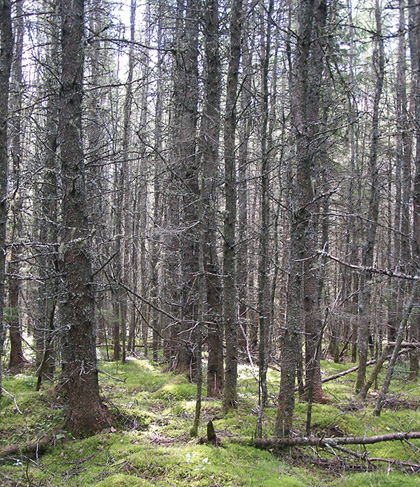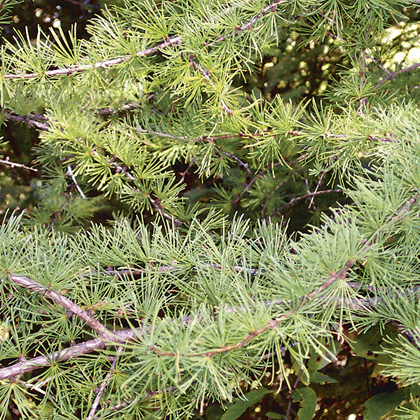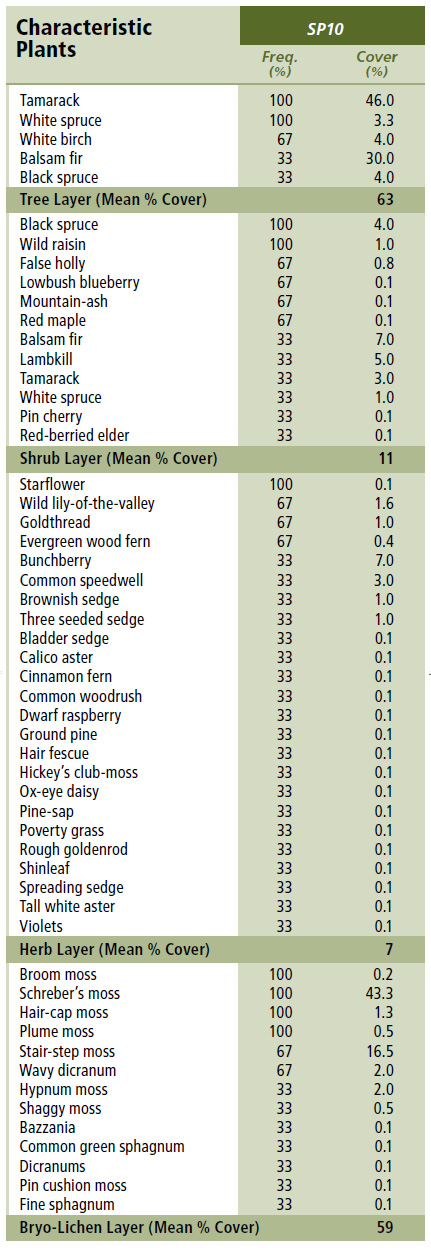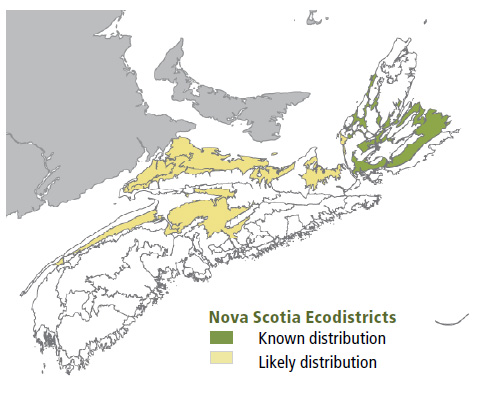
Forest Vegetation types - SP10
SP10 —Tamarack / Wild raisin / Schreber's moss
Larix laricina / Viburnum nudum / Pleurozium schreberi
 |
Stubbart Road, Margaree, Inverness County |
Concept: This early successional Vegetation Type (VT) has an overstory dominated by tamarack along with scattered white spruce. The susceptibility of tamarack to several defoliating insects reduces the likelihood this VT will attain advanced maturity. Tamarack / Wild raisin / Schreber's moss usually follows stand-replacing disturbances such as fire, windthrow or harvesting.
Vegetation: Tamarack is the dominant overstory tree. The shrub layer consists mainly of wild raisin and regenerating black spruce. Typical woodland flora are found in the herb layer, along with species associated with past harvesting (e.g. asters, goldenrods, grasses and sedges). The bryophyte layer includes Schreber's moss, hair-cap moss, plume moss and broom moss. Moss coverage is often interspersed with needle carpet.
Environmental Setting: SP10 is associated with fresh to moist, nutrient poor to medium soils. This VT has only been found in the Inverness Lowlands and Bras d'Or Lowlands ecodistricts.
Successional Dynamics: Nutrient poor soils associated with this VT lead to an edaphic climax community dominated by black spruce. This even-aged VT follows stand-replacing disturbances, with harvesting the most common cause. As the tamarack succumbs to insect defoliation or senescence, SP10 will generally succeed to SP6 (Black spruce – Red maple / Bracken / Sarsaparilla) or directly to SP5 (Black spruce / Lambkill / Bracken), the edaphic climax for this successional pathway.
Ecological Features: This early successional ecosystem is a closed-canopy small-patch forest occurring in eastern Nova Scotia. Tamarack has a dense, strong wood, with high decay resistance, which contributes to the development of substantial coarse woody material, particularly when higher mortality occurs after insect predation, disease, or blowdown and breakage in wind storms. Tamarack is very intolerant of shade and will not regenerate under a closed canopy. Tamarack seeds are eaten by purple finches, and red and white-winged crossbills. Small mammals cache fallen cones, while porcupines and snowshoe hare eat tamarack bark. The larch sawfly periodically reaches epidemic levels, defoliating trees over successive years. The larch slippery jack fungus forms a mycorrhizal relationship with larch and often fruits abundantly in the fall.
 |
| Tamarack |
Distinguishing Features: A softwood forest dominated by tamarack on well to imperfectly drained soils and not found on old field sites. Asters, goldenrods, sedges and grasses are common in the understory.
| Slope Position: | Level10 |
Surface Stoniness: |
(Non - Slightly)7 (Very - Excessively)3 |
Bedrock Outcrop: |
(Non-rocky)10 |
Elevation Range: |
37 - 70m |
Slope Gradient: |
Level10 |
Aspect: |
East3 None7 |
Exposure: |
Moderate10 |
Microtopography: |
Moderately10 |
Drainage: |
Imperfect3 Moderately well3 Well3 |
Soil Type: |
ST27 ST33 |
Parent Material: |
Glacial till7 Glaciofluvial3 |
Rooting Depth (cm): |
(30-45)7 (>45)3 |
Duff Thickness (cm): |
(0-5)3 (6-10)3 (11-20)3 |

